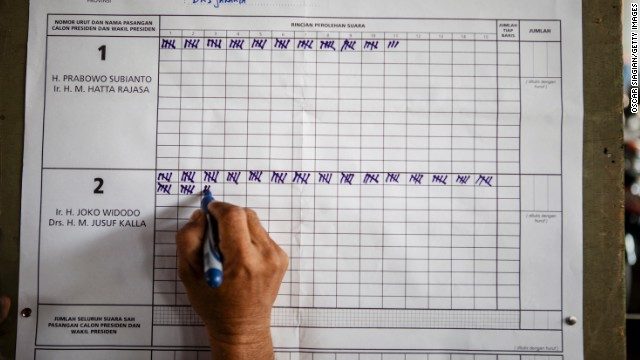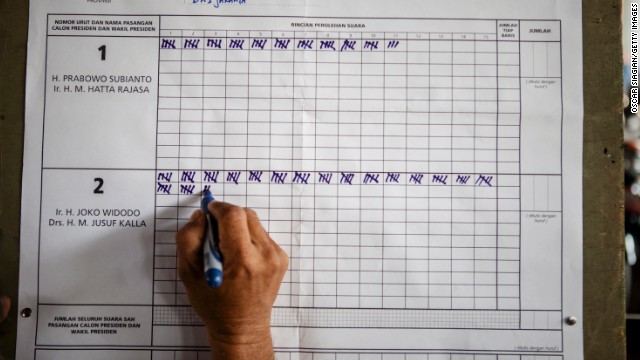In the immediate aftermath of Indonesia’s presidential election, there has been intense scrutiny of not only a rack of quick count results, but the institutions conducting these and the media promoting their findings. In what was already a tight race between Joko Widodo (Jokowi) and Prabowo Subianto, eight quick counts have Jokowi ahead while four show Prabowo leading. How should we read these quick counts? And how significant are they?
Quick count results are gleaned from a sample of final results from the polling station level–as distinct from exit polls, which are a survey of voters as they leave the polling station (and are therefore not final and subject to levels of voter comfort in honestly declaring their choice).
Campaign talking heads in Indonesia have attempted to discredit quick counts–particularly those that show results leaning against their candidate–by suggesting that surveying results from around 2,000 polling stations, from some 500,000 polling stations around the country, cannot give an accurate picture.
This is baloney. To paraphrase an old saying, you do not need to eat a whole bowl of soup to sample the flavor; just one taste will suffice–assuming all of the ingredients have been mixed well.
The “ingredients” refer to the methodology that ensures quick count integrity. Credible quick counts will use a random sample of polling stations, taking into account factors that have a sufficiently significant impact on the distribution of votes among voters across the country to ensure against bias in the data.
The survey institution will also apply layers of quality control, from intensive training of field workers to verification of data submitted and data entry. To cook quick count data, a disreputable surveyor could skew the sample in favor of regions known to be sympathetic to that surveyor’s political patron. Or they could just alter data before publishing.
As such, the integrity of the institutions conducting quick counts is important: to evaluate quick count results, look at not only who is conducting a quick count but who is funding it.
What is that institution’s track record in conducting similar surveys? Are they transparent about their institution, funding, methodology and data? Persepi, Indonesia’s Public Opinion Survey Association, is one body that promotes professionalism among their member institutions–including most of those that released quick count results on election day. They have announced that they will conduct an audit of the quick counts based on the significant difference in results.
Another criticism I heard levelled against the 9 July quick counts by one campaign spokesperson on television was that since many had similar results, they were clearly in cahoots to promote the other candidate.
Again, there is an element of baloney here. Many of the quick counts announced results with a margin of error of around 0.7 per cent.
How does one interpret the margin of error? Margin of error is the acceptable level of error in a survey. If we take a rough average of most of the reputable quick count results (and by reputable, I refer to my criteria above for institutions with a solid track record of similar surveys), Jokowi’s margin of victory was approximately 52 per cent to 48 per cent for Prabowo. Applying the margin of error of 0.7 per cent, means that the result for Jokowi could be read as between 51.3 per cent and 52.7 percent; likewise, for Prabowo the result would be between 47.3 per cent and 48.7 per cent. Simply put, if quick counts are conducted well, then the results should all closely resemble each other.
There is another layer in interpreting quick count results. We need to look not only at the institutions conducting these counts, but the media that promote and often pay for their findings. And the media during this presidential election campaign have been more partisan than ever.
Television provides the most stark example. On election day, RCTI used the Indonesia Research Centre (IRC) count that had Prabowo ahead. MNC and TV One only cited three quick counts–from JSI, Puskaptis and LSN–all of which had Prabowo ahead. Metro TV, meanwhile, cited several surveys–including Kompas, RRI and the Saiful Mujani Research Center (SMRC)–each of which had Jokowi ahead . MNC, RCTI and IRC are owned by Hary Tanoesoedibjo, who has openly backed Prabowo’s campaign. Aburizal Bakrie, the Chairman of Golkar and whose family owns TV One, has also backed Prabowo. Metro TV, meanwhile, is owned by Surya Paloh, the founding Chairman of Nasdem–which is part of Jokowi’s coalition. And so each side is able to promote their own version of the truth, as told, and sold, through quick counts.
Why should we care so much about these quick counts in the first place? The easy answer is that each side has declared victory based on quick count results–so they cannot be ignored. The more important reason relates to a history of fraud during the official vote count in Indonesian elections. We only need to go back three months to the April legislative elections to find numerous allegations of electoral officers rigging the vote count. Credible and reputable quick counts in Indonesia give us a reliable benchmark, as well as a basis of evidence, against which to assess the official result, which will be announced by 22 July.
Political polling, including quick counts, is now well established and well accepted in Indonesia. For example, president Yudhoyono quickly acknowledged and accepted the SMRC quick count after the April elections and cited these in challenging his Democrat party to do better.
The National Election Commission once flirted with the idea of banning quick counts, but now simply requires all institutions conducting exit polls and quick counts to register with them in advance. The solution is not to restrict these important contributions to our understanding of elections and voters, but to survey the surveyors to sort out the wheat from the chaff and ensure that bogus survey institutions–and their backers–cannot capitalise from muddying the data pool and corrupting the overall integrity of the election process.
Andrew Thornley is a program director for The Asia Foundation in Indonesia. He can be reached at andrew.thornley@asiafoundation.org. The views and opinions expressed here are those of the individual author and not those of The Asia Foundation.
 Facebook
Facebook  Twitter
Twitter  Soundcloud
Soundcloud  Youtube
Youtube  Rss
Rss 
